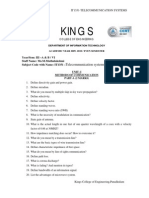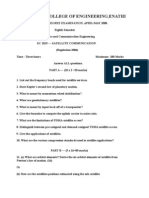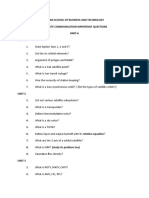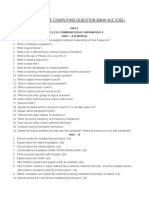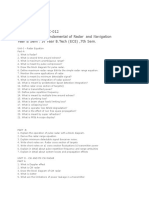0 ratings0% found this document useful (0 votes)
215 viewsQuestion Bank Unit-I: Ec1015-Satellite Communication
Question Bank Unit-I: Ec1015-Satellite Communication
Uploaded by
malathi_sharavanan9625This document contains questions and answers related to the subject of Satellite Communication. It is divided into 5 units covering various topics:
1. Overview of satellite systems, orbits and launching methods
2. Geostationary orbit and space segment
3. Earth segment and space link
4. Satellite access
5. Direct broadcast satellite services
The questions range from short 2-mark questions to longer 16-mark questions requiring detailed explanations. The document serves as a question bank to test knowledge of concepts in satellite communication.
Copyright:
Attribution Non-Commercial (BY-NC)
Available Formats
Download as DOC, PDF, TXT or read online from Scribd
Question Bank Unit-I: Ec1015-Satellite Communication
Question Bank Unit-I: Ec1015-Satellite Communication
Uploaded by
malathi_sharavanan96250 ratings0% found this document useful (0 votes)
215 views6 pagesThis document contains questions and answers related to the subject of Satellite Communication. It is divided into 5 units covering various topics:
1. Overview of satellite systems, orbits and launching methods
2. Geostationary orbit and space segment
3. Earth segment and space link
4. Satellite access
5. Direct broadcast satellite services
The questions range from short 2-mark questions to longer 16-mark questions requiring detailed explanations. The document serves as a question bank to test knowledge of concepts in satellite communication.
Original Title
EC1015-QB
Copyright
© Attribution Non-Commercial (BY-NC)
Available Formats
DOC, PDF, TXT or read online from Scribd
Share this document
Did you find this document useful?
Is this content inappropriate?
This document contains questions and answers related to the subject of Satellite Communication. It is divided into 5 units covering various topics:
1. Overview of satellite systems, orbits and launching methods
2. Geostationary orbit and space segment
3. Earth segment and space link
4. Satellite access
5. Direct broadcast satellite services
The questions range from short 2-mark questions to longer 16-mark questions requiring detailed explanations. The document serves as a question bank to test knowledge of concepts in satellite communication.
Copyright:
Attribution Non-Commercial (BY-NC)
Available Formats
Download as DOC, PDF, TXT or read online from Scribd
Download as doc, pdf, or txt
0 ratings0% found this document useful (0 votes)
215 views6 pagesQuestion Bank Unit-I: Ec1015-Satellite Communication
Question Bank Unit-I: Ec1015-Satellite Communication
Uploaded by
malathi_sharavanan9625This document contains questions and answers related to the subject of Satellite Communication. It is divided into 5 units covering various topics:
1. Overview of satellite systems, orbits and launching methods
2. Geostationary orbit and space segment
3. Earth segment and space link
4. Satellite access
5. Direct broadcast satellite services
The questions range from short 2-mark questions to longer 16-mark questions requiring detailed explanations. The document serves as a question bank to test knowledge of concepts in satellite communication.
Copyright:
Attribution Non-Commercial (BY-NC)
Available Formats
Download as DOC, PDF, TXT or read online from Scribd
Download as doc, pdf, or txt
You are on page 1of 6
EC1015-SATELLITE COMMUNICATION
DEPARTMENT OF ELECTRONICS AND COMMUNICATION
ENGINEERING
QUESTION BANK
SUB.CODE : EC1015 SUB.NAME : SATELLITE COMMUNICATION
YEAR : IV SEMESTER : VIII
UNIT-I
OVERVIEW OF SATELLITE SYSTEMS, ORBITS AND LAUNCHING
METHODS
PART-A (2 Marks)
1. What are the major regions are classified the world for frequency planning?
2. How many broadcasting services provided in satellite?
3. What is meant by distance insensitive?
4. List out the coverage area for INTELSAT?
5. What are the classify the Domsats in terms of power?
6. State Kepler’s first law.
7. State Kepler’s second law.
8. State Kepler’s third law.
9. Define apogee and perigee.
10. Define prograde orbit and retrograde orbit.
11. Define ascending node and descending node.
12. Explain right ascension of ascending node.
13. Define true anomaly and mean anomaly.
14. What is meant by argument of perigee?
15. List out the keplerian elements.
16. What are the quantities involved for determination of look angles?
17. Define sidereal time.
PART-B
1. (a) Explain about frequency allocations for satellite services. (10)
(b) Explain about U.S Domsats. (6)
2. Discuss briefly the development of INTELSAT starting from the 1960s through the
present. (16 )
3. What is meant by polar orbiting and explain in details. (16)
4. State Kepler’s three laws of planetary motion. Illustrate in each case their
relevance to
artificial satellites orbiting the earth. (16)
5. Explain in detail about geocentric-equatorial coordinate system which is based on
the
earth’s equatorial plane. (16)
6. Explain in detail about topocentric-horizon coordinate system which is based on
the
observer’s horizon plane. (16)
7. Explain in detail about various measure of time. (16)
UNIT-II
GEOSTATINARY ORBIT AND SPACE SEGMENT
PART-A ( 2 Marks)
1. What are the three conditions are required for an orbit to be geostationary?
2. Find height of geostationary orbit based on aE and aGSO.
3. What is meant by look angles how to classify it.
4. Define elevation angle.
5. Define azimuth angle.
6. What are the three pieces of information needed to determine the look angles for
the
geostationary orbit?
7. What is meant by polar mount antenna?
8. Define geosynchronous.
9. What is meant by the geostationary orbit? How do the geostationary orbit and a
geosynchronous orbit differ?
10. Why satellites to carry batteries in addition to solar-cell arrays?
11. What is meant by satellite attitude?
12. Define the terms roll, pitch and yaw.
13. What is meant by the term despun antenna?
14. Define nutation dampers.
15. Define momentum bias and reaction wheel.
16. Describe the east-west and north-south station keeping maneuvers required in
satellite station keeping.
17. What is meant by thermal control and why this is necessary
in a satellite?
18. What are the functions carried out in TT&C?
19. What is meant by transponder?
20. What is meant by frequency reuse?
21. What is meant by redundant receiver?
22. Define attenuators and explain its classification.
23. Describe the function of the input demultiplexer used aboard a communication
satellite.
24. Why TWTAs widely used?
25. What is meant by slow wave structure?
26. List out the advantages are TWT.
27. Define saturation and compression point.
28. What is meant by intermodulation distortion?
29. Define input back off.
30. Define diplexer and orthocoupler.
PART-B
1. Explain in detail about antenna look angles and the polar mount antenna. (16 )
1. Explain about Earth eclipse of satellite and sun transit outage. (16)
2. Explain about launching orbits. (16)
3. Explain what is meant by satellite attitude, and briefly describe two forms of
attitude
control. (16)
4. Draw the block diagram of TT&C and explain each and individual blocks. (16 )
5. Describe briefly the most common type of high-power amplifying device used
aboard
a communication satellite. (16)
6. Explain about wideband receiver and advanced Tiros-N spacecraft. (16)
7. Describe briefly the antenna subsystem and Anik-E. (16)
8. Explain in detail about thermal control and Morelos. (16 )
UNIT-III
EARTH SEGMENT AND SPACE LINK
PART-A ( 2 Marks)
1. What is meant by DBS service? How does differ from the home reception of
satellite
TV signals in the C band?
2. What is meant by polarization interleaving?
3. What is meant by master broadcast quality signals?
4. What are the difference between DBS TV and conventional TV?
5. Why the LNA in a satellite receiving system is placed at the antenna end of the
feeder cable.
6. What is meant by single carrier per channel?
7. In most satellite TV receivers the first IF band is converted to a second, fixed IF.
Why is this second frequency conversion required?
8. What is meant by the term redundant earth station?
9. List out the comparison between MATV and CATV.
10. Define EIRP.
11. Define receiver feeder losses.
12. What is meant by antenna pointing loss?
13. Write the equation for clear-sky losses and explain each term.
14. What is meant by noise power spectral density?
15. What is meant by intermodulation noise?
16. How to broadly classify the antenna noise and explain.
17. What is meant by antenna noise temperature?
18. What is meant by amplifier noise temperature?
19. What is meant by system noise temperature?
20. What is meant by noise factor?
21. Write the equation for system noise temperature.
22. Define saturation flux density.
23. Define apparent absorber temperature.
24. Define quantum efficiency and responsivity.
25. What is meant by excess noise factor?
PART-B
1. Describe and compare the MATV and CATV systems. (16)
2. Write the relevant expression and explain in detail about transmission losses.
(16)
3. How to classify the system noise temperature and explain in detail about all. (16)
4. Explain about uplink satellite circuit. (16)
5. Explain about downlink satellite circuit. (16)
6. Describe briefly about the rains effects. (16)
7. Explain about inter-satellite link. (16)
8. With the aid of a block schematic, briefly describe the functioning of the receive
only
home TV systems (16)
UNIT-IV
SATELLITE ACCESS
PART-A ( 2Marks)
1. What is meant by single access?
2. Distinguish between preassigned and demand assigned traffic in relation to a
satellite communications network.
3. What is meant by thin route service?
4. What is meant by centrally controlled random access and distributed control
random
access?
5. Explain the word spade.
6. Define the term power-limited and bandwidth limited operation.
7. What is meant by demand assignment signaling and switching?
8. What are the advantages of TDMA over FDMA?
9. Define the term burst and frame.
10. Define burst rate and average bit rate.
11. What do you meant by guard time?
12. Explain carrier and bit-timing recovery.
13. Explain burst code word.
14. Define the term preamble and postamble.
15. What is meant by burst position acquisition and burst position synchronization?
16. What is meant by adaptive open loop timing?
17. Explain the term lookback.
18. Define the terms miss probability and probability of false alarm.
19. Define satellite channel and satellite channels.
20. What is meant by digital speech interpolation and digital
Noninterpolated?
21. What is meant by telephone load activity factor and digital speech interpolation?
22. What is meant by spread spectrum multiple access?
23. What is meant by direct sequence spread spectrum?
24. Define maximal sequence?
25. List out the advantages of CDMA over FDMA and TDMA.
26. List out the advantages of CDMA in terms of VSAT.
27. Define throughput efficiency.
PART-B
1. Explain what is meant by single access in relation to a satellite communications
network. Give an example of the type of traffic route where single access would be
used. (16)
2. Explain in detail about FDMA, and show how this differs from FDM. (16)
3. Explain what the abbreviation SCPC stands for. Explain in detail the operation of a
preassigned SCPC network. (16)
4. Explain in detail the operation of the spade system of demand assignment. What
is
the function of the function of the common signaling channel? (16 )
5. Describe the general operating principles of a TDMA network. Show how the
transmission bit rate is related to the input bit rate. (16 )
6. Explain the need for reference burst and preamble and postamble in a TDMA
system. (16)
7. Explain in detail about network synchronization with neat sketch. (16)
8. Define and explain the terms carrier recovery, traffic data, frame efficiency and
channel capacity. (16 )
9. Discuss briefly how demand assignment and preassignment may be implemented
in
TDMA network. What are the advantages of TDMA over FDMA in this respect?
(16)
10. Explain in detail about speech interpolation and prediction. (16 )
11. Explain in detail about satellite switched TDMA. (16 )
8. Describe briefly about on board signal processing for FDMA/TDM operation.
9. Describe in your own words how signal acquisition and tracking are achieved in a
DS/SS system. And also derive the expression for maximal sequence. (16 )
10. Explain in the principle behind spectrum spreading and dispreading and how this
is
used to minimize interference in a CDMA system. And also determine the
throughput efficiency of the system. (16 )
UNIT-V
DIRECT BROADCAST SATELLITE SERVICES
PART-A ( 2Marks)
1. What do you mean by direct broadcasting satellite services?
2. Define DTH.
3. Expand the term RARC and ISO/IEC.
4. How many MPEG standards available now.
5. What is meant by chroma sub sampling?
6. Draw the diagram of MPEG-2 sub sampling.
7. What is meant by spatial frequency?
8. What is meant by masking in the context of audio compression?
9. Define temporal masking and frequency masking?
10. Expand the terms MPEG, ITU, AVC and CCIR?
11. What is meant by fidelity range extension?
12. Define ideal parabolic surface in terms of rms.
13. What is meant by microsat?
14. List out the modes of operation in Radarsat-2.
15. What is meant by earth-centered, earth-fixed coordinate system?
16. What does the term dilution of precision refer to?
17. What does the term position dilution of precision factor of refer to?
18. Define GPS time.
19. Expand the terms GSM, GPS, orbcomm, GCC, NCC, GES, and OSC.
.PART-B
1. Describe briefly the video compression process used in MPEG-2. (16)
2. Explain about indoor and outdoor unit of home receiver. (16)
3. Explain about frequencies and polarization, transponder capacity and bit rates for
digital television. (16)
4. Explain in detail about satellite mobile services. (16 )
5. Describe the operation of typical VSAT system. State briefly where VSAT systems
find widest application. (16)
6. Describe the main features of Radarsat. Explain what is meant by dawn to dusk
orbit
and why the Radarsat follows such on orbit. (16)
7. Explain why a minimum of four satellites must be visible at an earth location
utilizing
the GPS system for position determination. What does the term dilution of precision
refer to? (16 )
8. Describe the main features and services offered by the orbcomm satellite system.
How do these services offered by geostationary satellites and terrestrial cellular
systems? (16 )
*************
You might also like
- Progress Check Unit 1B MCQ AnsDocument11 pagesProgress Check Unit 1B MCQ Ansryzewu2024100% (4)
- Units 4 and 5 - MCE IGCSE Physics Questions and AnswersDocument7 pagesUnits 4 and 5 - MCE IGCSE Physics Questions and AnswersMohab MqattashNo ratings yet
- Cea7 enDocument107 pagesCea7 enMarek KoniarekNo ratings yet
- Satellite Communication Previous Years Question PapersDocument13 pagesSatellite Communication Previous Years Question Papersshankar92% (12)
- Question Bank For Wireless CommunicationDocument10 pagesQuestion Bank For Wireless CommunicationPRIYA RAJI100% (2)
- Rig Inspection & SurveyDocument102 pagesRig Inspection & Surveyhshobeyri100% (1)
- SateDocument4 pagesSateDr. K. Sakthidasan Professor & Head I/C HTBI - ECENo ratings yet
- Satellite Communications Question BankDocument3 pagesSatellite Communications Question BankNaresh KumarNo ratings yet
- EC1015 Satellite CommunicationDocument8 pagesEC1015 Satellite CommunicationNagakumar RajNo ratings yet
- Ec2045 Satellite CommunicationDocument6 pagesEc2045 Satellite CommunicationSeekay Alais Karuppaiah CNo ratings yet
- EC1015 - Satellite CommunicationDocument8 pagesEC1015 - Satellite CommunicationRameez FaroukNo ratings yet
- Satellite CommunicationDocument6 pagesSatellite CommunicationselviNo ratings yet
- EC1403 Satellite CommunicationDocument5 pagesEC1403 Satellite CommunicationDr. K. Sakthidasan Professor & Head I/C HTBI - ECENo ratings yet
- Question Bank PDFDocument4 pagesQuestion Bank PDFkdtkopNo ratings yet
- CS2204 Adc V+ QBDocument4 pagesCS2204 Adc V+ QBJai RamNo ratings yet
- Kings: Question BankDocument6 pagesKings: Question BankmythulasiNo ratings yet
- Ec 1207 Analog and Digital Communication QBDocument4 pagesEc 1207 Analog and Digital Communication QBnofeelingrahulNo ratings yet
- Department of Electronics &telecommunication Engineering Sem:VIII Question Bank of Satellite CommunicationDocument4 pagesDepartment of Electronics &telecommunication Engineering Sem:VIII Question Bank of Satellite CommunicationPavan WaseNo ratings yet
- CMC-Q BankDocument5 pagesCMC-Q BankNaveen KumarNo ratings yet
- Satellite Communication Question PaperDocument2 pagesSatellite Communication Question PaperallanjwilsonNo ratings yet
- Final Important QuestionsDocument5 pagesFinal Important QuestionsNikhitha ThommandruNo ratings yet
- Cseitquestions - Blogspot.In Cseitquestions - Blogs Pot - in Cseitquestions - Blogspot.InDocument23 pagesCseitquestions - Blogspot.In Cseitquestions - Blogs Pot - in Cseitquestions - Blogspot.IndeepikaNo ratings yet
- Telemetry Question BankDocument5 pagesTelemetry Question BankMATHANKUMAR.SNo ratings yet
- Kings: Subject Code &Document6 pagesKings: Subject Code &balaji26182No ratings yet
- EC2311 Communication Engineering Question BankDocument6 pagesEC2311 Communication Engineering Question BankprmnthNo ratings yet
- WIRELESS-QUESTION-BANKDocument6 pagesWIRELESS-QUESTION-BANKangeliensilviyasNo ratings yet
- Satellite Ommunication Previous Year University Question PapersDocument39 pagesSatellite Ommunication Previous Year University Question PapersShanmugapriyaNo ratings yet
- 7.university Question PaperDocument2 pages7.university Question Papergurulakshmi05No ratings yet
- Solved QuestionsDocument3 pagesSolved QuestionsSoumyadeep DasNo ratings yet
- Kings: Question BankDocument6 pagesKings: Question BankGokul KumarNo ratings yet
- Gojan School of Business and Technology Satellite Communication Important Questions Part-A UNIT-1Document3 pagesGojan School of Business and Technology Satellite Communication Important Questions Part-A UNIT-1Dharani KumarNo ratings yet
- Satellite Communication QB KongunaduDocument4 pagesSatellite Communication QB KongunadushankarNo ratings yet
- Question BankDocument6 pagesQuestion BankbhathiyaengNo ratings yet
- Department of Electronics and Communication Engineering: Apollo Engineering College, ChennaiDocument3 pagesDepartment of Electronics and Communication Engineering: Apollo Engineering College, Chennaiapollo eceNo ratings yet
- Cs9251 Mobile Computing Question BankDocument16 pagesCs9251 Mobile Computing Question BankNivitha100% (1)
- 8th Sem-IT 1403-Mobile ComputingDocument11 pages8th Sem-IT 1403-Mobile ComputingJuliet JJNo ratings yet
- Cs9251 Mobile Computing Question BankDocument16 pagesCs9251 Mobile Computing Question BankNivithaNo ratings yet
- Principles of Communication Question BankDocument8 pagesPrinciples of Communication Question BankShaniya FathimuthuNo ratings yet
- PCOMDocument6 pagesPCOMShruthi BhatNo ratings yet
- Satellite Communication Important QuestionDocument1 pageSatellite Communication Important QuestionETCB12Shrutika DevanpalliNo ratings yet
- Question Bank For Satellite CommunicationDocument4 pagesQuestion Bank For Satellite CommunicationVijai PrabhuNo ratings yet
- EC6004 SC Rejinpaul Important QuestionsDocument3 pagesEC6004 SC Rejinpaul Important QuestionsRajesh Kumar100% (1)
- QBDocument8 pagesQBRathore Yuvraj SinghNo ratings yet
- EC6801 IT Wireless CommunicationDocument10 pagesEC6801 IT Wireless CommunicationAnbu ArasanNo ratings yet
- Mobile CommunicationDocument8 pagesMobile CommunicationsrinimehaNo ratings yet
- EC6801 IT WirelessCommunicationquestionbankDocument10 pagesEC6801 IT WirelessCommunicationquestionbankEASACOLLEGENo ratings yet
- Dronacharya College of Engineering, GR - Noida.: Q6.Explain Bridges, Routers, Gateways and Different LevelDocument4 pagesDronacharya College of Engineering, GR - Noida.: Q6.Explain Bridges, Routers, Gateways and Different Levelshyamsagar15No ratings yet
- MicrowaveDocument5 pagesMicrowaveragh1291No ratings yet
- Part - A (10x2 20 Marks)Document5 pagesPart - A (10x2 20 Marks)Immanuel VinothNo ratings yet
- Department of Information Technology Question Bank Subject Name: Principles of Communication Year / Sem: II/III Unit - I Part-A (2 Marks)Document4 pagesDepartment of Information Technology Question Bank Subject Name: Principles of Communication Year / Sem: II/III Unit - I Part-A (2 Marks)apecevsbNo ratings yet
- ECE S508 Question BankDocument2 pagesECE S508 Question BankMMhammed AlrowailyNo ratings yet
- Ec 63 - (Antennas and Wave Propagation) Question BankDocument9 pagesEc 63 - (Antennas and Wave Propagation) Question BankJeslin AntonioNo ratings yet
- Question Bank Subject Code: TEC-012 Subject Name: Fundamental of Radar and Navigation Year & Sem: IV Year B.Tech (ECE), 7th SemDocument4 pagesQuestion Bank Subject Code: TEC-012 Subject Name: Fundamental of Radar and Navigation Year & Sem: IV Year B.Tech (ECE), 7th Semkumar_csunilNo ratings yet
- Communication Engineering Two Mark QuestionDocument3 pagesCommunication Engineering Two Mark QuestionTim RobinsonNo ratings yet
- Ec2311 QBDocument3 pagesEc2311 QBlekashrimaniNo ratings yet
- Mic QbankDocument8 pagesMic QbankSuganya RajamanickamNo ratings yet
- RS - Unitwise Important QuestionsDocument3 pagesRS - Unitwise Important QuestionsJanardhan Ch100% (2)
- EC1013Document4 pagesEC1013mythulasiNo ratings yet
- Why Should The Transmit and Receive Antenna Be Placed at Far FieldsDocument2 pagesWhy Should The Transmit and Receive Antenna Be Placed at Far FieldsSuresh KumarNo ratings yet
- TNT NTN AtennaDocument1 pageTNT NTN Atennavj86No ratings yet
- Radio Propagation and Adaptive Antennas for Wireless Communication Networks: Terrestrial, Atmospheric, and IonosphericFrom EverandRadio Propagation and Adaptive Antennas for Wireless Communication Networks: Terrestrial, Atmospheric, and IonosphericNo ratings yet
- Handbook of Defence Electronics and Optronics: Fundamentals, Technologies and SystemsFrom EverandHandbook of Defence Electronics and Optronics: Fundamentals, Technologies and SystemsNo ratings yet
- Radio Spectrum Management: Policies, Regulations and TechniquesFrom EverandRadio Spectrum Management: Policies, Regulations and TechniquesNo ratings yet
- Allowable Rotational Speed Mounting: Examples of Identification NumberDocument4 pagesAllowable Rotational Speed Mounting: Examples of Identification NumberFilippo ArcelliNo ratings yet
- CVPPPPPDocument4 pagesCVPPPPPVeronica ApallaNo ratings yet
- Traffic Signs, Markings and ApprtDocument91 pagesTraffic Signs, Markings and Apprtkumarnram50% (2)
- Pubchem FingerprintsDocument18 pagesPubchem Fingerprintsproduct developmentNo ratings yet
- Tyre-Flex Coupling DeatilsDocument19 pagesTyre-Flex Coupling DeatilsDnyanesh BhaleraoNo ratings yet
- Control Systems LectureDocument217 pagesControl Systems LectureJames Joseph100% (1)
- IOL Power CalculationDocument27 pagesIOL Power CalculationAisha TahirNo ratings yet
- Advanced Computer Architecture CSE 8383Document56 pagesAdvanced Computer Architecture CSE 8383shettyc90No ratings yet
- Introduction & SetDocument10 pagesIntroduction & Setsde.ofcl20No ratings yet
- Lam IntroductionToR LHLDocument212 pagesLam IntroductionToR LHLDr. ANUJ TEWARINo ratings yet
- Forensic Engineering of Fire-Damaged Concrete StructuresDocument10 pagesForensic Engineering of Fire-Damaged Concrete Structuresstevecabrera100% (1)
- Equilibrium Concentration of Interstitial AtomsDocument11 pagesEquilibrium Concentration of Interstitial AtomsSamarjeet Kumar SinghNo ratings yet
- GMA Waterjet Grade Product Data SheetDocument1 pageGMA Waterjet Grade Product Data Sheetuntung budiNo ratings yet
- GREENROCK - Business - Technische Daten - V02 - EngDocument24 pagesGREENROCK - Business - Technische Daten - V02 - EngZasfaried RafsanzaniNo ratings yet
- LV Power ProtectionDocument4 pagesLV Power ProtectionBerhanu ZelalemNo ratings yet
- R 5 KB 0010 / 0016 E: Busch Vacuum Pumps and SystemsDocument2 pagesR 5 KB 0010 / 0016 E: Busch Vacuum Pumps and Systemsfadi bkNo ratings yet
- DingLi MOS Measurement ToolDocument17 pagesDingLi MOS Measurement ToolhcagasNo ratings yet
- EMI Calculation On LoanDocument2 pagesEMI Calculation On LoanamitfinanceNo ratings yet
- QUICK STUDY NOTES in EARTH SCIENCE Q2 W1Document6 pagesQUICK STUDY NOTES in EARTH SCIENCE Q2 W1Hector PantiNo ratings yet
- Chem 40.1 Msds Exer 6Document7 pagesChem 40.1 Msds Exer 6Angela Sietereales RamosNo ratings yet
- Unit-V: VHF, Uhf and Microwave AntennaDocument31 pagesUnit-V: VHF, Uhf and Microwave AntennaNuzhath FathimaNo ratings yet
- Test Bank For Burtons Microbiology For The Health Sciences 9 North Americanth Edition Paul G EngelkirkDocument10 pagesTest Bank For Burtons Microbiology For The Health Sciences 9 North Americanth Edition Paul G Engelkirkraphaelsophiep9f9100% (29)
- E Commerce Presentation ReportDocument30 pagesE Commerce Presentation ReportazmirNo ratings yet
- Davies 2002, The Effects of Fluctuating Seasonal and Constant Wáter Temperatures On The Photoperiodic AdvancementDocument18 pagesDavies 2002, The Effects of Fluctuating Seasonal and Constant Wáter Temperatures On The Photoperiodic AdvancementDARWIN SALAMANCA CANSAYANo ratings yet
- Geometry Practice Quiz For High School StudentsDocument3 pagesGeometry Practice Quiz For High School StudentsGyermie Ross CarpesoNo ratings yet
- SPC For MS Excel V2.0 Demo InstructionsDocument12 pagesSPC For MS Excel V2.0 Demo InstructionsDanu MamlukatNo ratings yet


















